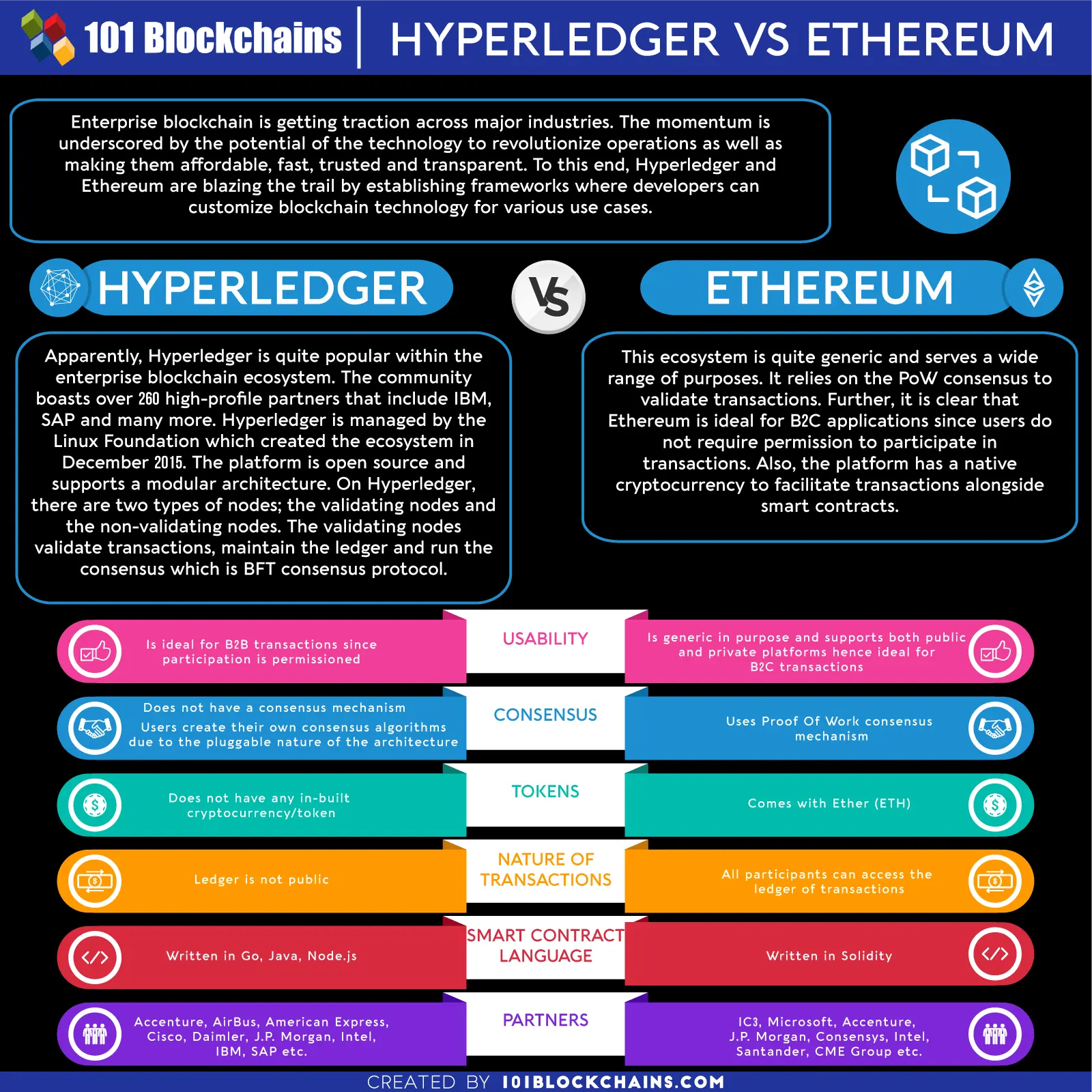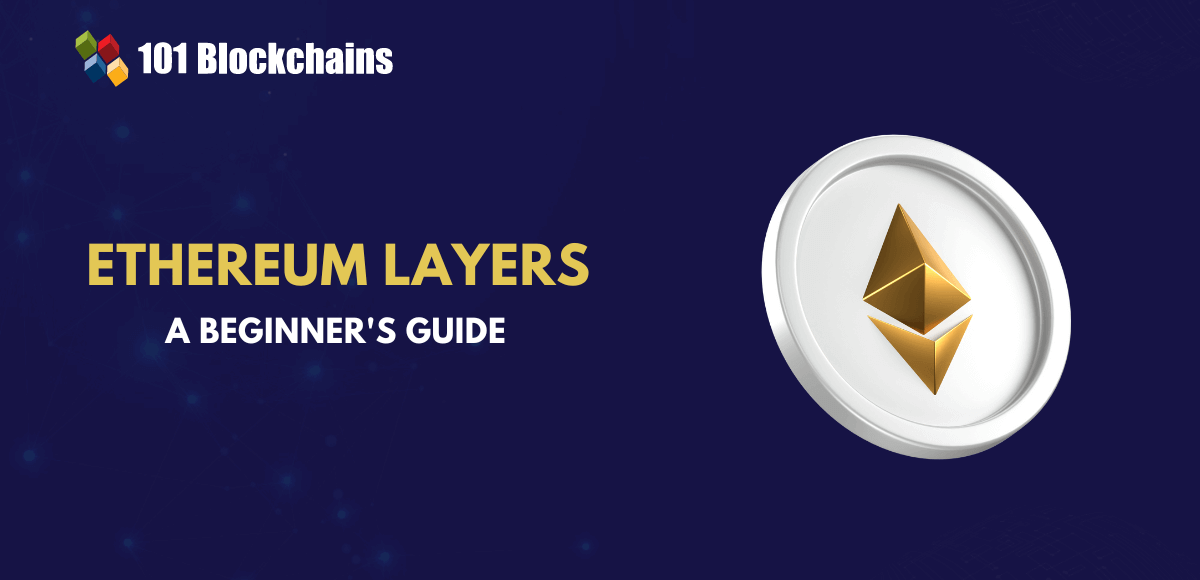Learn how blockchain truly works, master key definitions, and uncover what makes smart contracts so "smart." Dive into the fundamentals, gain valuable insights, and start your blockchain journey today!

- Ethereum
Hasib Anwar
- on March 18, 2021
Hyperledger vs Ethereum: A Clash of Two Emerging Technologies
This article compares the two most popular blockchain platforms — Hyperledger and Ethereum, along with the basic concepts of these two platforms.
As the need for blockchain technology and attendant solutions goes mainstream, demand for enterprise blockchains is rising. Already, platforms like Hyperledger and Ethereum are making huge advances in that direction. So, it’s not surprising that you are thinking about which platform could be best suited for your needs. Therefore, we bring you the Hyperledger vs Ethereum comparison.
It will surely help you out to make the right choice. So, let’s begin!
Excited to build your skill in Ethereum development by leveraging the ethers.js library? Enroll Now in Ethers.Js Blockchain Developer Course!
A Clash of Two Emerging Technologies
There are some emerging technologies including artificial intelligence (AI), robotics, Virtual Reality (VR), augmented reality (AR) among others. So, it’s quite fair to say that every single price of technology come with their own set of features, right?
More specifically all of these technologies came to be because of the need for the market. But I think you already know by now that blockchain did not emerge in a typical way.
Blockchain came about as the underlying technology of bitcoin and later thousands of cryptocurrencies started to use it. Ethereum Foundation took the technology a notch higher by introducing smart contracts. With the solution, users could make transactions directly without the need for a central entity to enforce the trust.
Ethereum gave all of use a new kind of feature, and it tried to outgrow the typical flows in the original blockchain. But now the technology had already caught the eye of the legacy firms. However, with the full public aspect of the technology, they couldn’t use it properly.
And therefore, we have Hyperledger. Hyperledger came with the relevant set of privacy an enterprise could ever need.
To this end, enterprise blockchain platforms came up to help firms deploy the technology.
Enterprise blockchain platforms solve some of the key challenges involved in the use of blockchain technology at the enterprise level. Notably, the platforms help firms to keep their data private whereby every member of the platform has to get permission to access the platform.
Interestingly, blockchain technology is built by a decentralized community where all information recorded on the ledger is public and distributed among all the users. This is where blockchain gets its other designation as distributed ledger technology (DLT).
Want to learn the basic and advanced concepts of Blockchain and Hyperledger Fabric? Enroll Now: Getting Started with Hyperledger Fabric Course
Hyperledger vs Ethereum
Please include attribution to 101blockchains.com with this graphic. <a href='https://101blockchains.com/blockchain-infographics/'> <img src='https://101blockchains.com/wp-content/uploads/2019/03/Hyperledger-Vs-Ethereum.png' alt='Hyperledger Vs Ethereum='0' /> </a>
What Is Hyperledger?
The Linux Foundation came up with the idea of creating a hub that gives a platform of open-source efforts to customize blockchain to work for enterprises. Hyperledger blockchain brings together high-profile participants like IBM that seek to exploit the potential of the technology. Just like Ethereum, Hyperledger provides the platform for developers to come up with applications that offer smart solutions for various industries.
Unlike other platforms, Hyperledger is a bit different. They have a lot of projects under their bags, and all of these platforms have a modular design. So, in many cases, all you’d need to do is plug in the feature you want and start using it.
Founded in December 2015, the project does not support a coin like Ethereum. Notably, Hyperledger introduces a completely different idea of a blockchain network that is not transactional at its core. This is to say that the peers within a Hyperledger ecosystem are the various enterprises looking to exploit the technology.
Build your identity as a certified blockchain expert with 101 Blockchains’ Blockchain Certifications designed to provide enhanced career prospects.
Hyperledger Projects
Hyperledger is the most adapted enterprise blockchain network compared to rivals like Corda and Ethereum. Moreover, the network is quite popular with industries that rely on complex and sophisticated supply chains that are prone to failure and lack of integrity.
Also, Hyperledger has some partners each of who are interested in using the DLT to solve certain problems. There are over 260 members and hundreds of individual project each year is built on Hyperledger.
On all of these projects of Hyperledger, each one focuses on a given problem. Some of them include Hyperledger Explorer which enables developers to see the health of their platforms. Notably, Hyperledger Explorer acts like Google Chrome where users can explore various information stored on a public ledger.
Another project is Hyperledger Sawtooth which aims to provide solutions for the financial industry as well as the Internet of Things (IoT). Created by Intel, the platform uses a consensus mechanism that is different from that of traditional blockchain platforms. For instance, the bitcoin network uses the Proof-of-Work (PoW) mechanism. On the contrary, Sawtooth Lake uses the Proof of Elapsed Time (PoET) algorithm to facilitate transactions.
Among other Hyperledger projects, Hyperledger Fabric is the most popular. What sets Fabric apart from other platforms on the Hyperledger ecosystem is that it enables developers to create applications using general purpose programming languages like Go, Java, and Node.js.
However, in other blockchain platforms, we mainly see developers to use domain specific languages like C++, COBOL, Python, and so on.
Check out the comparison between Hyperledger Fabric vs Sawtooth vs Composer.
Hyperledger Fabric
Hyperledger Fabric comprises of an architecture that is easily configurable as well as quite modular. Such an architecture is easy to understand, and developers can work their way around with ease.
As such, developers experience the versatility and that they can optimize the platform for various use cases in industries such as healthcare, insurance, banking, supply chain and more. The platform is leading innovations in the said fields with solutions like TradeLens already deployed to facilitate operations in the shipping industry.
Like Ethereum, IBM Hyperledger (Hyperledger Fabric) uses smart contracts to facilitate transactions between peers. Also, the platform requires users to confirm their identity before access to ensure that trust is maintained.
What Is Ethereum?
Ethereum is among the foremost iterations of the bitcoin blockchain network. As a public blockchain, Ethereum is not suitable for enterprise purposes for reasons cited earlier. Therefore, some developers and a handful of corporations came together to develop Enterprise Ethereum which could help the firms exploit blockchain.
Later, the Enterprise Ethereum Alliance was born. Particularly, the alliance aims to customize the Ethereum blockchain network to apply to industries. So, it’s a win-win scenario, isn’t it?
Notably, firms would like to utilize the smart contract capability of Ethereum to enhance trust in their business transactions. Further, the firms can exploit other properties like immutability of data, transparency and data integrity to keep track of operations across their supply chains.
Already, EEA has some high-profile industry partners including Accenture, Microsoft, British Petroleum and J.P. Morgan & Chase. Moreover, all of these industries come from a various type of industries. These organizations want to increase the diversity of the blockchain altogether. So, Ethereum could a good option for you.
Excited to learn the basic and advanced concepts of ethereum technology? Enroll Now in The Complete Ethereum Technology Course
Projects Based on Ethereum Architecture
Alliance members are modifying the Ethereum platform so that they can come up with enterprise-grade offerings. So, you will see many vendors offering Ethereum enterprise solution, which is mostly a modified version to suit your need.
For instance, Microsoft created a blockchain function in its Microsoft Azure platform to allow developers to create applications for enterprises. Furthermore, Microsoft Azure deploys Blockchain-as-a-Service (BaaS) such that technology helps to streamline business operations.
This is just an example of Ethereum vendors. Mainly their primary target is to focus on developing quality standard open-source blockchain solutions for the enterprise. In this way, they want to regain the trust between the businesses and the consumers. Currently, they have more than 350+ members under their wings.
Want to know more about BaaS? Enroll Now: Getting Started with AWS Blockchain as a Service (BaaS)
The Quorum Platform
Another popular platform based on Ethereum is J.P. Morgan’s Quorum. As per the bank, Quorum is a private blockchain network built on Ethereum that focuses on enterprise solutions. Notably, the platform has a clear bias toward the financial industry.
Here, developers can create applications that require high transaction speeds as well as guaranteed security. According to the team behind Quorum, the platform provides answers to various challenges that blockchain is facing toward enterprise adoption.
The Quorum platform stands on three key pillars that J.P. Morgan believes other platforms are lacking to gain mass enterprise adoption. First, there is the issue of trust. Like earlier discussed, blockchain platforms operate in a decentralized manner. So, it means that there isn’t any central authority to enforce compliance and to guarantee trust.
In this light, Quorum is an open source where users can vet and establish its veracity. Further, the platform supports signature validation so that all the users on the platform are only those that are legitimate.
Secondly, Quorum rests on the community. The fact that the source code is freely available ensures that many more people can experiment with the architecture of the platform. This furthers the sense of inclusion which also encourages diverse perspectives within the ecosystem.
Lastly, Quorum claims to be mature in the sense that it deeply integrates with Ethereum. This is to say that any improvements that happen on Ethereum platform will take place in Quorum. Furthermore, it will ensure that the architecture of the platform is not left behind given the fast-moving nature of the blockchain ecosystem.
Hyperledger vs Ethereum: What Are The Key Differences?
Let’s see what the main differences between Hyperledger vs Ethereum are. We’ll go with each point individually. So, let’s start!
-
Purpose
The first most typical difference between IBM Hyperledger vs Ethereum is the reason for their design.
Ethereum uses a smart contract on the Ethereum Virtual Machine for different applications to use decentralization and make it great for mass consumption. On the other hand, Hyperledger mainly targets the blockchain for enterprises. Moreover, it’s designed to suit a higher degree of confidentiality for the platforms.
Also, to make the platform scalable and resilient. So, they made the design modular or make it more expandable in the future quite easily. But Ethereum does not have a modular structure.
-
Confidentiality
To make this point clear, let us give you an example. Let’s say you run a pastry manufacturing industry using blockchain. If you use Hyperledger, you would be able to sell a specific customer with discounted pricing. But you won’t have to disclose this agreement to other customers.
On the other hand, if you used Ethereum to be the platform you might not be able to have that confidentiality. Why? Well, the transaction on Ethereum is public, so everyone will be able to see your transitions with another party.
So, in terms of confidentiality, between the wars of IBM Hyperledger vs Ethereum, Hyperledger wins.
-
Peer Participation
Now let’s see what the mode of peer participation in IBM Hyperledger vs Ethereum is.
You can use Ethereum in both ways – public or private, and you won’t be needing any permissions for that. However, Hyperledger is a permissioned private network.
It means that in Ethereum anyone can join the network at any time. But Hyperledger will approve a set of predefined members to get access. Moreover, they will also decide who can join the consensus and who can’t.
-
Consensus Mechanism
Another key difference between Hyperledger vs Ethereum is the consensus algorithms. In Ethereum they use Proof of Stake as a consensus algorithm. This mechanism is overly slow and depends on everyone on the network to reach a single point of agreement. Furthermore, this protocol is also power hungry, so it would take up a lot of your power to reach the agreement.
On the other hand, Hyperledger lets the users choose between No-Op, or an agreement protocol (PBFT) to reach the verdict. So, all the parties agree in such a way that everyone can influence the outcome. So, any third party can’t force their decisions on the nodes. As it restricts the participation, scalability and privacy are reached.
-
Programming Languages
Another major difference between Hyperledger Fabric vs Ethereum is the use of smart contracts. Typically, in Ethereum, developers use Solidity to write the core.
On the other hand, Hyperledger Fabric uses the term “chaincode’ to describe their smart contracts. These contracts are written in Golang. It’s a programming language created by Google, which is quite easy to learn. Moreover, these chaincodes maintain the business logic of the network so that you can consider them as smart contracts.
-
Cryptocurrency
The main difference between Hyperledger Fabric vs Ethereum is the lack of a token economy in Hyperledger. Yes, Hyperledger does not have any cryptocurrency in their architecture. But if you need one then you are free to create on your own, you will get the tools to create one.
On the other hand, Ethereum has a cryptocurrency called Ether. So, you will be able to use this token on the platform to transact or offer other services. But if we look at both sides, Ethereum does have more advantages over Hyperledger because it can also be used as a business for consumers.
Want to become a Cryptocurrency expert? Enroll Now in Cryptocurrency Fundamentals Course
-
Compared to Ethereum Private Network
How would Ethereum private network vs Hyperledger compare? The Ethereum private network is an off-chain platform that enables developers to run tests faster and cheaply.
Notably, running tests over the Ethereum MainNet requires that one buys Ethereum (ETH) using real money. Then, one will use the ETH to buy gas that is necessary to conduct operations over an Ethereum platform. Also, one would have to run the whole Ethereum code which is bulky and would take too long to download, install and configure.
On the contrary, an Ethereum private network is lightweight and only mimics the actual Ethereum platform. Therefore, the platform is easy to install and configure. Also, one would not need gas to run tests within the private network. As such, one will not incur any costs other than the disc space required to hold the code of the network.
In light of this, it is clear that an Ethereum private network vs Hyperledger comparison would lead us to the fact that Ethereum private network is only good for running tests for projects intended to be built within the Ethereum ecosystem.
On the other hand, Hyperledger is a platform where developers can build private or public networks and applications to solve legacy and emerging problems.
Hyperledger vs Quorum
Like earlier discussed, Hyperledger is an umbrella project that brings together various institutions with a common interest. Hyperledger provides a platform where developers can create networks to select use cases in various industries. We have already seen that there are projects like Hyperledger Fabric that are doing well.
In comparing Hyperledger vs Quorum, it is just like looking at the strengths and weaknesses of IBM Hyperledger against Quorum. To be sure, Hyperledger fabric is superior to Quorum in terms of transaction speed. Notably, the network can achieve up to 3,500 tps. On the contrary, Quorum can manage only a few hundreds of tps (transaction per second).
The Structure of the Networks
For more depth in Hyperledger vs Quorum, we need to go to consensus level. When it comes to consensus, we earlier noted that Hyperledger Fabric consensus has an innovative mechanism where transactions are executed before being registered on the blockchain. So, Ethereum consensus mechanism is inferior compared to Hyperledger Fabric.
As such, this allows for higher transactions speeds in a secure and trusted environment. Clearly, this is opposed to the traditional order-execute model that other blockchain platforms support.
On the other hand, Quorum utilizes what the team calls QuorumChain. This is a consensus protocol that is quite straightforward as opposed to that for Hyperledger fabric. Here, the various nodes in the Quorum ecosystem reach consensus by “a simple majority vote.”
To be sure, every node on the Quorum platform has voting rights. By exercising the rights, the nodes will have a say on what transaction goes through and what transaction fails to meet the verification standards of the community.
Further, the QuorumChain consensus mechanism is pluggable and is based on Istanbul BFT and Raft consensus. Notably, the team settled for the consensus protocol due to the proven high fault tolerance. Further, the consensus protocols have a relatively faster block time, and that expedites and enhances the transaction finality on the platform.
Start learning Blockchain with World’s first Blockchain Career Paths with quality resources tailored by industry experts Now!
So, Which One Should You Pick?
Considering the practical level, you would need to choose between them, because both may be flexible, but they also have different aspects.
Ethereum is a generic platform with smart contracts engine. So, you can apply it almost anywhere. However, as it’s permissionless and provides full transparency, it would cost you privacy and scalability.
On the other hand, you won’t be seeing this issue in Hyperledger because of the permissioned nature. It makes the network scalable and private. Also, you’d be able to customize it for various applications.
We really hope this comparison of Ethereum vs Hyperledger helped you out. Now with some insight, you can make a choice yourself. Also, check out our Enterprise Blockchain Free Course.
*Disclaimer: The article should not be taken as, and is not intended to provide any investment advice. Claims made in this article do not constitute investment advice and should not be taken as such. 101 Blockchains shall not be responsible for any loss sustained by any person who relies on this article. Do your own research!







